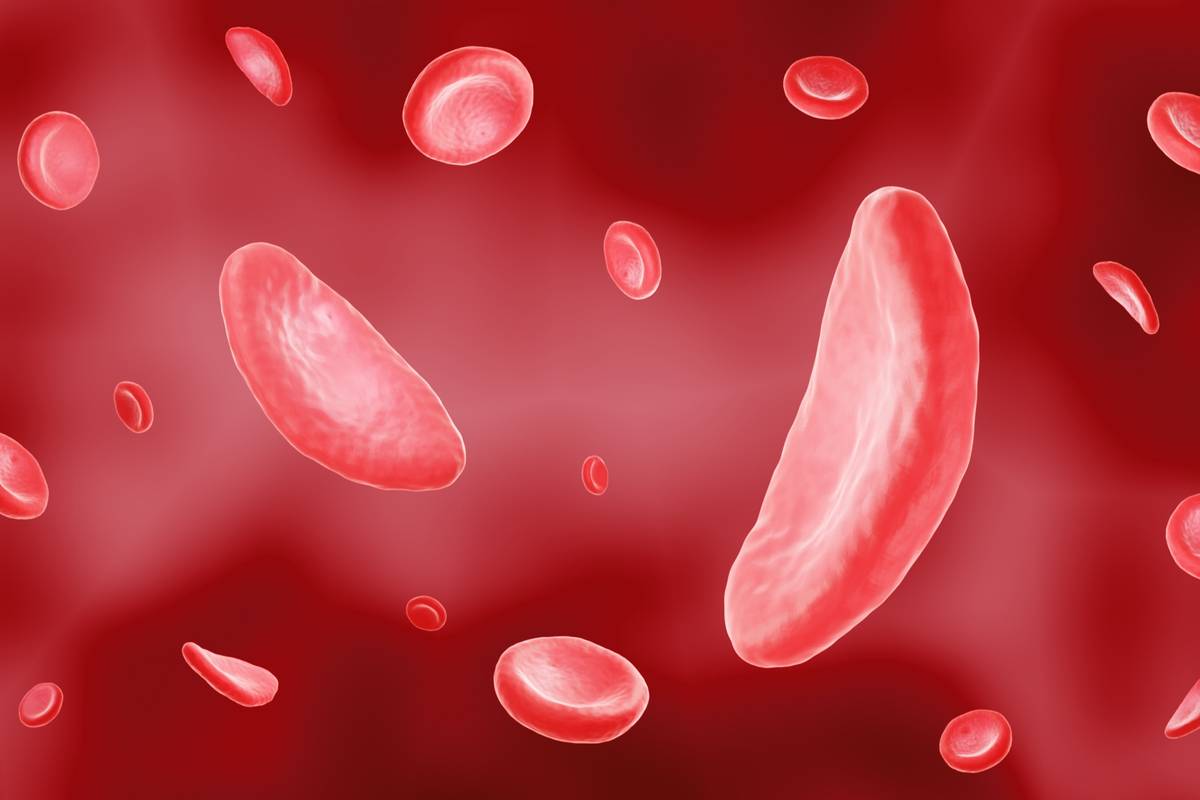A not so “uncommon” rare disease
Each year about 300,000 babies are born with sickle cell disease globally, with a vast majority in sub-Saharan Africa. Millions of people are suffering from the disease today, making it one of the most common monogenic disorders in the world.
What is Sickle Cell Disease (SCD)? Sickle cell disease is an inherited disorder caused by mutations in the HBB gene. Those mutations affect hemoglobin which is essential in oxygen transport in the body through red blood cells. The affected hemoglobin leads to the deformation of red blood cells that tend to be short-lived and causes anemia. The “sickle” shaped red blood cells also tend to aggregate and slow down or block blood flow. Blood vessel blockage causes the landmark complication of SCD called vaso-occlusive crisis (VOCs). VOCs are recurrent, associated with sharp acute pain and can result in progressive organ damage and other life-threatening complications including infections, acute chest syndrome, and strokes.
Significant remaining unmet needs
So far, 3 drugs have particularly impacted the treatment of the disease
Major advancement in disease management has been made throughout the years. Life expectancy of SCD patients has been extended from 20 years in the 1970s to 50 years today.
Since its approval in 1998, hydroxyurea remains the standard of care and helps ensuring the supply of oxygen in the body and reducing VOCs. Blood transfusions also help manage anemia. Then in the span of 3 years, 3 newly approved drugs significantly increased treatment options with fewer side effects for SCD patients:
- The first was L-glutamine (Endari®). This small molecule developed by Emmaus Medical was approved by the FDA in July 2017, aiming to reduce sickling of red blood cells and VOCs for patients over 5.
- Crizanlizumab (Adakveo®) was developed by Novartis and approved by the FDA in November 2019. This monoclonal antibody aims to reduce VOCs for patients over 16.
- The same month, Voxelotor (Oxbryta®), a small molecule developed by Pfizer and aiming to reduce sickling and preventing anemia for patients over 12, was approved by the FDA.
Nevertheless, current SCD medication does not guarantee successful treatment
Additionally, bone marrow transplant is currently the standard curative treatment but the procedure is invasive, risky and not guaranteed to be a success, less than 20% of patients find a compatible donor. SCD treatments available today only aim at reducing the risk of complications and prolonging life, resulting in a poor quality of life for patients with SCD. They are still living with intense pain and experiencing recurrent VOCs. On average, an SCD patient suffers from about 5 VOCs per year. Above all, their life expectancy is still reduced by 30 years and huge regional disparities exist as 50–90% of children with SCD in sub-Saharan Africa die by the age of 5. Given the high burden of the disease, finding innovative and effective treatments remains a pressing need for millions of patients around the world.
Will gene modifying SCD medication be the solution?
Major players boost the development of new treatments
The pharmaceutical industry is aware that there are significant remaining unmet needs in the field and are heavily investing in SCD. This currently translates into roughly 40 companies investigating about 40 new drugs. Major players are heavily investing in the field and are sponsoring most trials. Roche and Novo Nordisk are looking to enter the space quietly, while Pfizer and Novartis are confirming their commitment in SCD, including efforts to respectively extend voxelotor and crizanlizumab indications to the pediatric population with trials in phase III. Through the recent acquisition of Global Blood Therapeutics in October 2022, Pfizer is building a strong portfolio including an existing asset and several on-going programs investigating multiple modalities (i.e., small molecules and monoclonal antibodies). Novo Nordisk also acquired Forma Therapeutics with the ambition of building a leading portfolio in SCD and more globally in rare blood disease. Established biopharmaceutical companies such as Vertex Pharmaceuticals, Bluebird Bio and Agios Pharmaceuticals and more early-stage biotechnology companies like Editas Medicine or BEAM Therapeutics are also actively working on new treatments and seeking to enter the SCD field.
As SCD is a monogenic disease, developing gene therapy seems to be a promising option
More than half of the new treatments investigated are small molecules seeking to improve some of the key burden and symptoms of the disease, including reducing the occurrence of VOCs and increasing hemoglobin blood levels. Additionally, Pfizer also has a Phase III clinical trial investigating a monoclonal antibody aiming to reduce the occurrence of VOCs and VOCs requiring hospitalization. However, some companies are betting on gene-modifying and editing technologies to change the game. As SCD is a monogenic disease, gene therapy could be the winning curative strategy. The two latest-stage programs are an ex-vivo gene-edited stem cell therapy using the CRISPR/Cas9 technology named Exa-cel, and a gene therapy based on transplantation of hematopoietic stem cells transduced with a functioning β-globin gene. Both therapies, respectively sponsored by Vertex Pharmaceuticals in partnership with CRISPR Therapeutics and by Bluebird Bio, are currently being evaluated by the FDA and their decision is expected for December 8th and 20th. However, Exa-cel, now known as CASGEVY™, is one step ahead as it has received regulatory authorization by MHRA in the UK as of November 16th. However, the road to patient access can still be long as Vertex will now have to enter discussions with U.K.’s National Institute for Health and Care Excellence (NICE) on the cost-effectiveness of the treatment.
Learn more about how our team can support you in your projects related to rare diseases >
Sickle cell disease is a fast-evolving space as pharmaceutical companies are heavily investing in the field. The first new treatment accessible to patients will most likely be a gene-modified cell therapy aiming to reduce severe VOCs. There will however still be significant remaining unmet needs for SCD patients, on which Alcimed is ready to support you. Don’t hesitate to contact our team!
About the author,
Julie, Senior Consultant in Alcimed’s Life Sciences team in the U.S.



